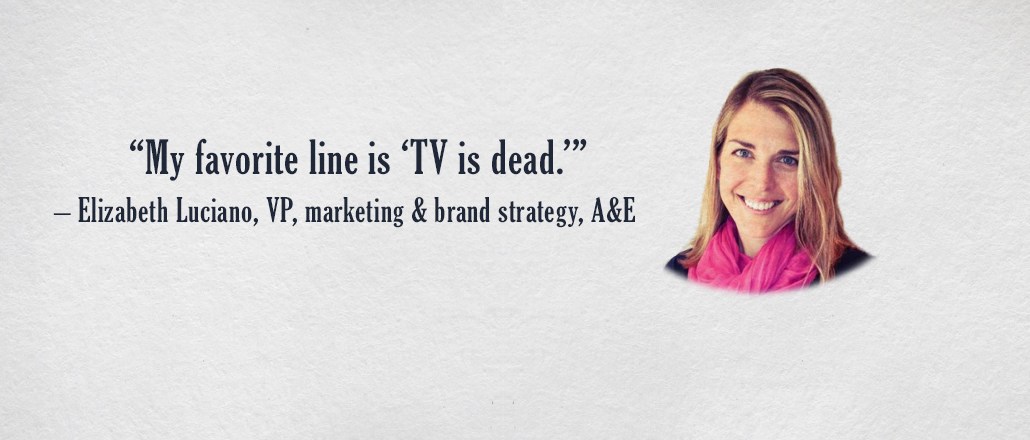
This is ThinkTank, a series where we quiz brand chiefs and CMOs on where the industry is heading.
Elizabeth Luciano had a busy weekend. While everyone else was winding down getting ready for the workweek, the VP of marketing and brand strategy at A&E Networks spent her Sunday night masterminding a large scale social TV project for the network’s Critics Choice TV Awards.
In an effort to make TV more social — and digital — Luciano, along with agency 360i, spearheaded the project, which lest viewers at home send real drinks to TV stars, just by tweeting at them. “There are a lot of award shows in the television landscape and the challenge is always how we are going to stand out,” said Luciano. “The best thing we can do is to give people as much access to celebs as possible.”
The awards, which aired Sunday, had 1.8 million Twitter users talking about the event, with a total of 8.5 million impressions, according to Nielsen.
Digiday chatted with Luciano about making the idiot-box DVR-proof and why working at an agency is the best thing she ever did.
Are people watching TV?
Absolutely yes. My favorite line is “TV is dead.” Every quarter a bunch of services release numbers on the TV that people watch. What’s happening is that the number of hours people watch TV hasn’t trended downward. What has changed is that people are watching less TV on TV and consuming more digitally.
But there have been ratings declines.
For most networks, we have seen a downward trend in ratings. But that’s not because people aren’t watching TV. It’s because there’s more TV to watch; there’s a lot more fragmentation. People are shifting the time they watch shows. With “Vikings,” our most popular drama, our audience size doubles over three days. We have numbers for Monday nights, but then with DVR those numbers literally double over three days.
So live TV is a good thing.
With the awards we just did, we did all this research and found that people who are watching awards shows want to see celebs in their natural environment. So we need to do as much as we can for that. For the film awards last year, every table had an iPad. We educated people on how to use it, and we allowed celebrities sitting at the table take selfies and we would upload and send out photos to the masses. That turned out to be a big hit.
Next, moving to the television awards, we knew we needed to allow people even more access. TV has much more rabid fanbases than film. We asked people for fan art and got celebs to pose in front of it. We were really happy with the fan participation. The runaway hit was the “tweet your favorite star a drink.” It actually was good because, we didn’t know this, but they were closing the main bar inside, so the celebs were super happy. [The network chose the drinks that were tweeted so celebs wouldn’t get drunk on thousands of glasses of champagne.]
One glass of champaign for Jessica Lange please, from me and Janet McTeer in the back… #tweetadrink
— Maggie Gyllenhaal (@mgyllenhaal) June 1, 2015
How has your job changed in this landscape?
Our jobs have gotten more complicated, it’s like a hamster running on a wheel. Understanding consumer behavior is so hard. There’s so much more to mine. A lot of what we look at when we go out and market shows is who that particular show would attract. Right now, our business model is built off that first “premiere” number. But that’s not enough. Yes, we need to drive them in when the show airs, but now we want to create fandoms over time. It’s not like movie marketing, where you drive people to a theater. So our questions are: Do we push catch-up viewing in between seasons?
Where does your site and app come into play?
They’re really part of driving frictionless viewing. They keep saying we need to flow fluidly between screens. So we’re trying. It’s an on-demand culture.
It’s also a binge-watching culture.
Oh yes. We gave an award away on Sunday night for the most binge-worthy show, “The Walking Dead” won. It’s a brand new award. And all our properties, like History Channel, when Winter Storm Juno was about to hit New York, we pushed this “hunker down, watch our shows,” thing for Vikings.
You came over from the agency side. What did you learn from that?
I think starting in the ad space and agency space is so important. You learn the particular facets of the business and it allows you to specialize. I think it’s good to sit on the agency side because so much of being an effective client is understand how to work with an agency. You learn a little bit about what type of relationship produces the best work.
More in Marketing

How the MAHA movement influenced food and beverage brands in 2025
The MAHA movement has come to stand for different things in different people’s eyes, depending on which initiatives they most closely follow.

Why Georgia-Pacific is turning its programmatic scrutinty to the sell side
The company is turning its attention to the sell side, zeroing in on the ad tech firms that move inventory for publishers — the supply-side platforms.

Future of Marketing Briefing: Why ‘just good enough’ is generative AI’s real threat to marketers
When characters and mascots are allowed to live inside generative systems, they stop being event-based and start becoming environmental.





